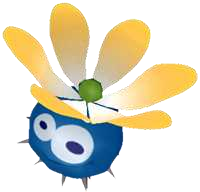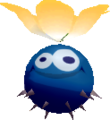Seedy Pod
| Seedy Pod | |
|---|---|
 Artwork from Super Mario Sunshine | |
| First appearance | Super Mario Sunshine (2002) |
| Latest appearance | Super Mario 3D All-Stars (2020) |
| Variant of | Pokey Head |
Seedy Pods,[1] also known as Yunbos,[2][3] are enemies that appear in only one game—Super Mario Sunshine. They are a variety of Pokey Pod with yellow flowers and blue skin. Seedy Pods are encountered in only two courses—Bianco Hills and the Red Coin Field. When approached, a Seedy Pod burrows underground while launching its seeds at would-be attackers. A Seedy Pod can be defeated by stunning it with water from a safe distance and then jumping on top of it. A Seedy Pod typically drops a coin when defeated, but in the Red Coin Field, it drops a Red Coin instead. Seedy Pods can be heard singing and seen dancing when one is standing far away, and they are represented by musical notes during this. A Seedy Pod can be eaten by a Yoshi while in its invincible state.
Gallery[edit]
Names in other languages[edit]
| Language | Name | Meaning | Notes |
|---|---|---|---|
| Japanese | たねまきサンボ[4][5] Tane Maki Sanbo |
Seed-scattering Pokey | |
| Italian | Pod in germoglio[6] | Blooming Pod | |
| Marghilarva[7] | Portmanteau of Marghibruco ("Pokey") and "larva" | Super Mario Bros. Encyclopedia | |
| Spanish | Pokeytín[8][9] | Portmanteau of "Pokey" and poquitín ("a very little bit"); compare with Pokeyto |
References[edit]
- ^ Hodgson, David S J; Stratton, Bryan; Stratton, Stephen (September 3, 2002). Super Mario Sunshine Prima's Official Strategy Guide. Prima Games (American English). ISBN 0-7615-3961-1. Page 17.
- ^ Loe, Casey (August 12, 2002). Super Mario Sunshine Perfect Guide. Versus Books (American English). ISBN 1-931886-09-1. Page 34.
- ^ Bogenn, Tim; Walsh, Doug (2002). Super Mario Sunshine Official Strategy Guide. BradyGAMES (American English). ISBN 0-7440-0180-3. Page 7.
- ^ Takashi, Watanabe, Noriko Oketani, Geesen Ueno, Mitsuharu Orihara, Tatsuhiko Mizutani, and Yasushi Nakahara, editors (2002). 『スーパーマリオサンシャイン 任天堂公式ガイドブック』. Tokyo: Shogakukan (Japanese). ISBN 4-09-106064-1. Page 19. Retrieved from Imgur.
- ^ Sakai, Kazuya (ambit), kikai, Akinori Sao, Junko Fukuda, Kunio Takayama, and Ko Nakahara (Shogakukan), editors (2015). "Super Mario Sunshine" in『スーパーマリオブラザーズ百科: 任天堂公式ガイドブック』. Tokyo: Shogakukan (Japanese). ISBN 978-4-09-106569-8. Page 99.
- ^ Hodgson, David S. J., Bryan Stratton, and Stephen Stratton (2002). Super Mario Sunshine Guida Strategica Ufficiale realizzata da Prima Games. Translated by Associazione Culturale Go!. Giaveno: Yoo Too Videogames, Prima Games (Italian). ISBN 88-900922-1-1. Page 17.
- ^ Sakai, Kazuya (ambit), kikai, Akinori Sao, Junko Fukuda, Kunio Takayama, Ko Nakahara (Shogakukan), and Marco Figini, editors (2018). "Super Mario Sunshine" in Super Mario Bros. Enciclopedia. Translated by Marco Amerighi. Milan: Magazzini Salani (Italian). ISBN 889367436X. Page 99.
- ^ In-game name displayed on the scoreboard of the Lakitu Cup from Mario Golf: Toadstool Tour.
- ^ Sakai, Kazuya (ambit), kikai, Akinori Sao, Junko Fukuda, Kunio Takayama, and Ko Nakahara (Shogakukan), editors (2017). "Super Mario Sunshine" in Enciclopedia Super Mario Bros. 30ª Aniversario. Translated by Gemma Tarrés. Barcelona: Editorial Planeta, S.A. (European Spanish). ISBN 978-84-9146-223-1. Page 99.
| Pokeys | |
|---|---|
| Characters | Mega Paper Macho Pokey • Mummipokey • Punkey the Pokey Prince • The Pokey Triplets • Tower Power Pokey |
| Species | Big Pokey • Blow Hard • Cactus Jack • Dark Pokey • Drool Hard • Green Pokey • Hanging Blow Hard • Mad Pokey • Poison Pokey • Pokey • Pokey (heading) • Pokey (projectile) • Pokey Head • Pokey Mummy • Pokey Pom • Pokeynut • Pokeyplant • Seedy Pod • Skellokey • Snow Pokey • Spiked Fun Guy (Super Mario World 2: Yoshi's Island) • Spiky Snifit • Toothy |
